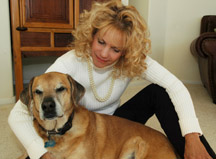If the science is correct, the good news is that we can change it on every level-from the conscious to the autonomic. When we alter our thoughts, are soothed by a kind authority, or are assured that we are in good hands, we can begin to feel the changes in our bodies-the softening of muscle fiber, the opening of bronchial tubes, the quieting of pain, the start of healing. This is why so much of Verbal First Aid in the field is directed to the alleviation of anxiety through the development and utilization of rapport. In rapport, a person will feel, "She understands me." "He is going to help me." "I'm safe, now." When we feel understood, our anxiety is reduced. And when anxiety is reduced, pain is relieved. Even if we are entirely alone, clinicians and scientists agree that what we say to ourselves matters and we can direct our thoughts so that our chances for survival are enhanced.
Self-Healing on The Trail
Whether you're speaking to yourself or to someone else on the trail, how you approach someone mentally and emotionally is at least as important as the medical expertise you have, according to Winnie Maggiore, former Asst. Chief of Placitas Volunteer Fire Brigade, paramedic, former Asst. D.A., and now a malpractice defense attorney. "We saw the same things in the wilderness that we saw locally-snake bites, mountain bike wrecks, breaks, falls, cardiac conditions-but the injuries in the wilderness feel worse to the patient in that he's away from familiar surroundings. Most of what we had to do in rescues was anxiety management. The first step is to let the person know you have the expertise to help. This conviction allowed us to say 'do this' in a way that motivated compliance."
The other major ingredient in dealing with crises on the trail, according to Maggiore, is giving people some sort of control over what is happening to them. "When we were just learning emergency medicine, we were given a course in hypnosis so it could be used in pain control, because it could be all we'd have to work with out there. The worst part for patients was being out of control so put them back in control as much as we could, gave them something positive to focus on. Panic is a patient's worst enemy."
People normally want to reassure with blanket statements, e.g., "you're fine." When this is obviously untrue, it's the sort of statement that breaks rapport. It's better to say, according to the experts, that the worst is over and you're there to help. Your caring presence is the cornerstone of the healing process. If you don't know what to say, say nothing and listen as you wait for help or do standard first aid. Your care can do more than you might imagine.               Â
          Â
The following are just two examples of ways we can talk to someone in distress so that they are calmed, their pain is reduced, and they are moved steadily towards healing
Asthma in the Sandias.
Sam and his son, Jared, went for a hike up the Tunnel Springs trail. Sam was sure Jared had packed his inhaler. Jared was sure his dad had packed it. When they got up to the first crest, Jared was straining for breath. When they realized they'd forgotten it, Sam was smart enough to take a deep breath himself so that when he turned to his son he was calm, focused, and sure-footed.
Sam:Â Â Â Â Â Jared, I can see you're breathing but that it's a little tight?
Jared:Â Â Â Â (Nods, but can't speak.)
Sam:      Sit with me here and lean forward like this. Put your head           forward like this so your bronchial tubes can open and smooth out. [At this point, Sam's voice drops in pitch and slows down so that it's soothing and controlled. He "paces" his son's breath with his own, carefully so as not to hyperventilate, just enough so that there is a joint rhythm. As he speaks to his son, his breathing slows down just a little bit at a time, "leading" his son back to normal breathing.) And as you do, you can remember very clearly how your inhaler feels when you take a puff on it, a little cool, a little tingly and how it opens you up pretty quickly, you can remember how it feels when it's working...a little more open now...a little more open, a little cooler, until you can get a really good deep, slow, even breath...
A Tumble Along La Luz      Â
The La Luz trail in Albuquerque, New Mexico, is full of crumbled granite that feels like a trot on a field of ball bearings and has brought more than one person to his or her knees. Cuts, abrasions, bites are exceedingly common crises. For that reason, while it's always smart to pack along a first aid kit, it's even smarter to know what to say to stop the bleeding and initiate a healthy immune response.
Sandra skids down the trail and slides into a sharp rock. When she gathers herself up, blood is pouring down her leg from a 3-inch laceration along the side of her calf. Her friend Kim, well-prepared for a full day hike, pulls out some Betadine, cleans the wound, applies sterile gauze on top of it and wraps it with a clean, cotton bandana. As she does, she speaks to her friend so that the bleeding stops and healing begins.
Sandra: Â Â Â Â Â Â Â Â Â Â Â Damn it! It's really bleeding.




